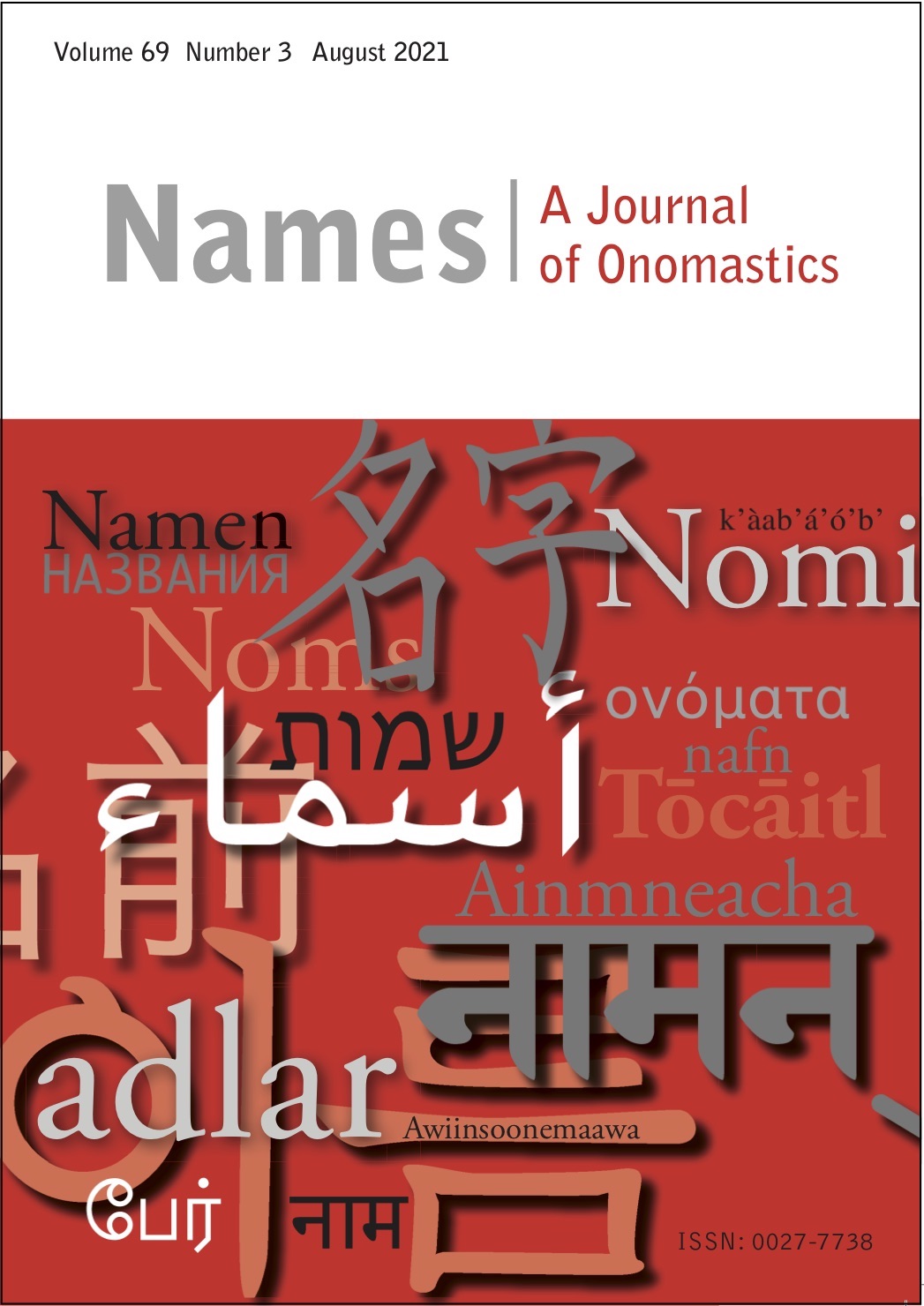“Boundary-Maintenance” or “Boundary-Crossing”? Name-Giving Practices among Immigrants in Germany
Published 2021-08-16
Keywords
- symbolic boundaries,
- boundary-making,
- immigrants,
- integration,
- Germany
- anthroponymy ...More
Copyright (c) 2021 Jurgen Gerhards, Julia Tuppat

This work is licensed under a Creative Commons Attribution 4.0 International License.
Abstract
This study investigates why some immigrants choose names for their children that are common in their home country whereas others opt for names used by natives in the host country. Drawing on the sociological literature on symbolic boundaries, the first strategy can be described as boundary-maintenance whereas the second can be classified as boundary-crossing. Using data from the German Socio-Economic Panel Study and applying bivariate and multivariate methods, two broader explanations for name-giving practices are tested: (1) cultural proximity and the permeability of the symbolic boundary between home and host country; and (2) immigrants’ levels of linguistic, structural, social, and emotional integration in the host country. Overall, the theoretical model explains the differences very satisfactorily. Whilst both sets of factors proved relevant to immigrants’ name-giving practices, the immigrants’ level of integration in the host country was less important than the cultural proximity between the origin group and host country.
References
- Alba, Richard. 2005. “Bright Vs. Blurred Boundaries: Second-Generation Assimilation and Exclusion in
- France, Germany, and the United States.” Ethnic and Racial Studies 28, no. 1: 20–49. doi:10.1080/
- Alba, Richard, and Victor Nee. 1997. “Rethinking Assimilation Theory for a New Era of Immigration.”
- The International Migration Review 31, no. 4: 826–874. doi:10.2307/2547416.
- Becker, Birgit. 2009. “Immigrants' Emotional Identification with the Host Society: The Example of Turkish
- Parents' Naming Practices in Germany.” Ethnicities 9, no. 2: 200–225. doi:10.1177/1468796809103460.
- Bundeszentrale f€ur politische Bildung 2018. “Bev€olkerung mit Migrationshintergrund I: In absoluten
- Zahlen, Anteile an der Gesamtbev€olkerung in Prozent, 2017.” Unpublished manuscript, last modified
- February 4, 2019. Accessed November 23, 2019. https://www.bpb.de/wissen/NY3SWU,0,0,
- Bev€olkerung_mit_Migrationshintergrund_I.html.
- Esser, Hartmut. 2001. “Integration und ethnische Schichtung.” Mannheimer Zentrum f€ur Europ€aische
- Sozialforschung.” Arbeitspapiere 40. Accessed November 23, 2019. http://www.mzes.uni-mannheim.de/
- publications/wp/wp-40.pdf
- Esser, Hartmut. 2006. Sprache und Integration: Die sozialen Bedingungen und Folgen des Spracherwerbs
- von Migranten. Frankfurt am Main: Campus-Verlag.
- Gerhards, J€urgen. 2005. The Name Game: Cultural Modernization and First Names. New Brunswick, NJ:
- Transaction Publishers.
- Gerhards, J€urgen, and Florian Buchmayr. 2018. “Unterschiede zwischen der ersten und zweiten Generation
- von Migrantinnen in der Wahrnehmung symbolischer Grenzen und in den Strategien ihrer Grenzarbeit.”
- Berliner Journal F€ur Soziologie 28, no. 3–4: 367–395.
- Gerhards, J€urgen, and Silke Hans. 2009. “From Hasan to Herbert: Name-Giving Patterns of Immigrant
- Parents Between Acculturation and Ethnic Maintenance.” AJS: American Journal of Sociology 114, no.
- : 1102–1128. doi:10.1086/595944.
- Goebel, Jan, Markus M. Grabka, Stefan Liebig, Martin Kroh, David Richter, Carsten Schr€oder, and J€urgen
- Schupp. 2019. “The German Socio-Economic Panel (SOEP).” Jahrb€ucher f€ur National€okonomie und
- Statistik 239, no. 2: 345–360. doi:10.1515/jbnst-2018-0022.
- Gordon, Milton M. 1964. Assimilation in American Life: The Role of Race, Religion, and National
- Origins. New York: Oxford University Press.
- Hans, Silke. 2010. Assimilation oder Segregation? Anpassungsprozesse von Einwanderern in Deutschland.
- Wiesbaden: Springer Fachmedien.
- Horowitz, Donald L. 1975. “Ethnic Identity.” In Ethnicity: Theory and Experience, edited by Nathan
- Glazer, Daniel P. Moynihan, and Corinne S. Schelling, 111–140. Cambridge, Massachusetts: Harvard
- University Press.
- Humpert, Andreas, and Klaus Schneiderheinze. 2000. “Stichprobenziehung f€ur telefonische
- Zuwandererumfragen: Einsatzm€oglichkeiten der Namenforschung.” ZUMA Nachrichten 24, no. 47:
- –63.
- Kalter, Frank. 2005. “Ethnische Ungleichheit auf dem Arbeitsmarkt.” In Arbeitsmarktsoziologie: Probleme,
- Theorien, empirische Befunde, edited by Martin Abraham and Thomas Hinz, 303–332. Wiesbaden: VS
- Verlag f€ur Sozialwissenschaften.
- Lamont, Michele, and Christopher Bail. 2008. “Bridging Boundaries: The Equalization Strategies of
- Stigmatized Ethno-Racial Groups Compared.” Center for European Studies Working Paper Series 154.
- Accessed November 23, 2019. https://ces.fas.harvard.edu/publications/000294-bridging-boundaries-theequalization-
- strategies-of-stigmatized-ethno-racial-groups-compared
- Levitt, Peggy, and B. N. Jaworsky. 2007. “Transnational Migration Studies: Past Developments and Future
- Trends.” Annual Review of Sociology 33, no. 1: 129–156. doi:10.1146/annurev.soc.33.040406.131816.
- Lieberson, Stanley. 2000. A Matter of Taste: How Names, Fashions, and Culture Change. New Haven,
- Connecticut: Yale University Press.
- Lieberson, Stanley, and Eleanor O. Bell. 1992. “Children's First Names: An Empirical Study of Social
- Taste.” American Journal of Sociology 98, no. 3: 511–554. doi:10.1086/230048.
- Lieberson, Stanley, Susan Dumais, and Shyon Baumann. 2000. “The Instability of Androgynous Names:
- The Symbolic Maintenance of Gender Boundaries.” American Journal of Sociology 105, no. 5:
- –1287. doi:10.1086/210431.
- J€URGEN GERHARDS AND JULIA TUPPAT
- Lieberson, Stanley, and Kelly S. Mikelson. 1995. “Distinctive African American Names: An Experimental,
- Historical, and Linguistic Analysis of Innovation.” American Sociological Review 60, no. 6: 928–946.
- doi:10.2307/2096433.
- Rossi, Alice S. 1965. “Naming Children in Middle-Class Families.” American Sociological Review 30, no.
- : 499–513. doi:10.2307/2091340.
- Skrobanek, Jan. 2009. “Perceived Discrimination, Ethnic Identity and the (Re-) Ethnicisation of Youth with
- a Turkish Ethnic Background in Germany.” Journal of Ethnic and Migration Studies 35, no. 4: 535–554.
- doi:10.1080/13691830902765020.
- Steinmann, Jan-Philip. 2019. “The Paradox of Integration: Why Do Higher Educated New Immigrants
- Perceive More Discrimination in Germany?” Journal of Ethnic and Migration Studies 45, no. 9:
- –1400

